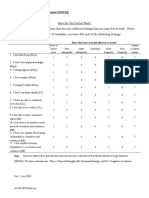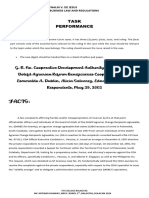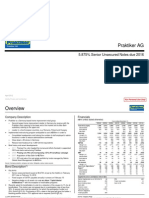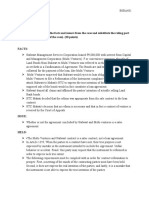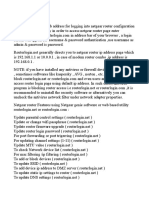0 ratings0% found this document useful (0 votes)
94 views02 Task Performance 1
02 Task Performance 1
Uploaded by
Kyla CastillanesThe document discusses opportunities to improve supply chain management in response to recent disruptions. It recommends that companies 1) map supply chains in detail to identify vulnerabilities, 2) diversify suppliers to mitigate risk from single-sourcing, 3) implement digital technologies to access and analyze supply chain data, 4) use streaming data and algorithms to establish dynamic inventory strategies, and 5) apply prescriptive analytics to interrogate data and model supply chain scenarios to make informed decisions. Addressing these opportunities could help companies strengthen resilience and responsiveness in their supply chains.
Copyright:
© All Rights Reserved
Available Formats
Download as DOCX, PDF, TXT or read online from Scribd
02 Task Performance 1
02 Task Performance 1
Uploaded by
Kyla Castillanes0 ratings0% found this document useful (0 votes)
94 views3 pagesThe document discusses opportunities to improve supply chain management in response to recent disruptions. It recommends that companies 1) map supply chains in detail to identify vulnerabilities, 2) diversify suppliers to mitigate risk from single-sourcing, 3) implement digital technologies to access and analyze supply chain data, 4) use streaming data and algorithms to establish dynamic inventory strategies, and 5) apply prescriptive analytics to interrogate data and model supply chain scenarios to make informed decisions. Addressing these opportunities could help companies strengthen resilience and responsiveness in their supply chains.
Original Description:
supply chain
Copyright
© © All Rights Reserved
Available Formats
DOCX, PDF, TXT or read online from Scribd
Share this document
Did you find this document useful?
Is this content inappropriate?
The document discusses opportunities to improve supply chain management in response to recent disruptions. It recommends that companies 1) map supply chains in detail to identify vulnerabilities, 2) diversify suppliers to mitigate risk from single-sourcing, 3) implement digital technologies to access and analyze supply chain data, 4) use streaming data and algorithms to establish dynamic inventory strategies, and 5) apply prescriptive analytics to interrogate data and model supply chain scenarios to make informed decisions. Addressing these opportunities could help companies strengthen resilience and responsiveness in their supply chains.
Copyright:
© All Rights Reserved
Available Formats
Download as DOCX, PDF, TXT or read online from Scribd
Download as docx, pdf, or txt
0 ratings0% found this document useful (0 votes)
94 views3 pages02 Task Performance 1
02 Task Performance 1
Uploaded by
Kyla CastillanesThe document discusses opportunities to improve supply chain management in response to recent disruptions. It recommends that companies 1) map supply chains in detail to identify vulnerabilities, 2) diversify suppliers to mitigate risk from single-sourcing, 3) implement digital technologies to access and analyze supply chain data, 4) use streaming data and algorithms to establish dynamic inventory strategies, and 5) apply prescriptive analytics to interrogate data and model supply chain scenarios to make informed decisions. Addressing these opportunities could help companies strengthen resilience and responsiveness in their supply chains.
Copyright:
© All Rights Reserved
Available Formats
Download as DOCX, PDF, TXT or read online from Scribd
Download as docx, pdf, or txt
You are on page 1of 3
Supply Chain Opportunities
Opportunities Description Recommendation
1. Limited Granularity of When China shut down, many For me I recommend that they
Data who thought they understood need to invest more resources
their supply chains discovered in understanding supply chain
that knowing Tier 1 suppliers complexity. I know it is not an
wasn't enough. Few easy task because on what we
appreciated the extent supply encounter but by applying this it
would be affected by the can improve our supply chain.
shutdown of Tier 2 and Tier 3 Also, they need to be ready and
suppliers located in the Wuhan find a solution in every
region and later, as the virus problems or challenge that we
spread, in other parts of the encounter.
world. Much of this was due to
faulty assumptions regarding
Tier 1 suppliers and possibly a
degree of wishful thinking. As
New York Governor Cuomo said
in his daily COVID-19 briefings,
"Let’s start with facts. While we
all have opinions, let’s start by
reviewing the facts."
It’s absolutely crucial
organizations map out their
supply chains, in detail, to
identify vulnerabilities and
weaknesses. This information
will allow fast and decisive
action when lower-level
supplies are threatened.
2. Single- source Amplifies For numerous reasons, many For me I recommend that they
Supply Chain Risk companies have focused on don’t need to focus on one
single-sourcing strategies, supplier they need to find other
possibly because this was suppliers that have same
perceived to be the lowest cost product on their business so
scenario. Unfortunately, this that they can overcome the
also means companies are supply chain risk. And by
vulnerable if suppliers face applying this it also improves
shortages or production your profits and you can avoid
interruptions. As Warren Buffet shortages of production.
said, "Only when the tide is out
do you discover who has been
swimming naked."
In a complex world facing the
sorts of supply chain challenges
referred to above, single
sourcing is risky and a
guaranteed way to lose sales
when disruption occurs.
Instead, companies should
focus on risk mitigation
strategies to anticipate and
minimize supply chain
challenges and risks.
3. Slowed digital Digital (transformation) could I recommend that the people
transformation enable leaders to make much who operate the digital
more intelligent decisions. This technologies needs to have a
is becoming more vital than training that can help them to
ever." operate properly by that it can
help them to monitor the data
Its crucial companies devise in the system and manage it
ways to access supply chain with an impact solution.
data through the introduction
of technologies that allow data
to flow freely through the
system. Additionally,
organizations need technologies
such as a supply chain digital
twin that allow them to
monitor, manage and observe
the impacts of decisions.
4. Maintaining Traditional Traditional inventory control I recommend that they need to
Inventory strategies strategies focus on past recommends that they need to
performance to determine use streaming data to drives
current inventory strategies. insight and also determine the
Precise algorithms are used to market shift and establish the
determine exact requirements. demand so that they can deal
The problem with this approach with the supply chain. Also, by
is that it doesn't take into using this you can get a better
consideration unexpected standard inventory solution.
events, nor is it agile and is
often completely divorced from
current realities.
5. Lack of Actionable Data A common theme facing I recommend that need to
and Insights business leadership, and supply interrogate data to determine
chain management in an optimal solution. Also they
particular, is they often don't need to apply prescript analytics
have sufficient information at because this can help to create
hand to make informed model supply chain that reflects
decisions. Added to that, supply works , all input and output
chain complexity makes it contain together . also, by using
difficult to evaluate multiple this it can organize to evaluate
alternatives, trade-offs and the different scenario and
scenarios to arrive at the best determine the best way to
or right decision. overcome supply chain
challenges and achieve supply
While traditional transactional- chain.
based ERP excels in handling
huge volumes of data, the way
information is captured,
handled and stored means it's
hard to use it for identifying
forward-looking trends. The
same applies to most business
analytics that are great for
reporting what happened in the
past, but provide limited insight
into future supply chain
challenges.
You might also like
- ShiromMelamedVigorMeasure EnglishDocument1 pageShiromMelamedVigorMeasure EnglishArturo Bueno RodríguezNo ratings yet
- Hoan My Rebrand BRIEFING - SMMDocument11 pagesHoan My Rebrand BRIEFING - SMMHue TruongNo ratings yet
- Case Analysis. (15 Points: 3 Items X 5 Points)Document1 pageCase Analysis. (15 Points: 3 Items X 5 Points)Shiella Mae BendecioNo ratings yet
- Gamefowl Breeding 101 - Steemit PDFDocument10 pagesGamefowl Breeding 101 - Steemit PDFGregorio Austria0% (1)
- 02 Task Performance 1Document2 pages02 Task Performance 1Ed Gierson PascualNo ratings yet
- Oblicon Reviewer Final DDocument119 pagesOblicon Reviewer Final DRoselle CasiguranNo ratings yet
- 02 Task Performance 1 - Prelim Exam - PMDocument3 pages02 Task Performance 1 - Prelim Exam - PMJosie Lou RanqueNo ratings yet
- Legaspi Oil Co., Inc. vs. The Court of Appeals and Bernard Oseraos (G.R. No. 96505 July 1, 1993)Document2 pagesLegaspi Oil Co., Inc. vs. The Court of Appeals and Bernard Oseraos (G.R. No. 96505 July 1, 1993)Gabriel TantiongcoNo ratings yet
- 01 Worksheet 2 (Online Version) - ARGDocument1 page01 Worksheet 2 (Online Version) - ARGJerico SantiagoNo ratings yet
- 03 Task Performance 1Document2 pages03 Task Performance 1Gersie TolentinoNo ratings yet
- Prefinal Exams 1stsem SY2018-2019 MCDocument3 pagesPrefinal Exams 1stsem SY2018-2019 MCAbraham Jr. ManansalaNo ratings yet
- 02 Quiz 1 Managerial AcctgDocument3 pages02 Quiz 1 Managerial AcctgRalph Louise PoncianoNo ratings yet
- Market Demand For Each ProductDocument2 pagesMarket Demand For Each ProductBetchang AquinoNo ratings yet
- Capalad CzerinaRose 10TaskPerformanceDocument3 pagesCapalad CzerinaRose 10TaskPerformanceAries Christian S PadillaNo ratings yet
- 03 Task Performance 1Document1 page03 Task Performance 1Dong RoselloNo ratings yet
- 02 Activity 1Document1 page02 Activity 1Wesley MorgaNo ratings yet
- Wiley CPAexcel - AUD - Assurance ServicesDocument11 pagesWiley CPAexcel - AUD - Assurance ServicesAimeeNo ratings yet
- Laboratory Exercise 1 - Intermediate Accounting 3Document1 pageLaboratory Exercise 1 - Intermediate Accounting 3Zeniah LouiseNo ratings yet
- Multi-Ventures Capital and Management Corp. v. Stalwart Management Services Corp.Document5 pagesMulti-Ventures Capital and Management Corp. v. Stalwart Management Services Corp.Tin Dychioco100% (1)
- 07 Task Performance 1Document2 pages07 Task Performance 1Emperor SavageNo ratings yet
- Quiz I. Problem Solving: Property of STIDocument2 pagesQuiz I. Problem Solving: Property of STIarisuNo ratings yet
- John Carlos B. Santos BSA301Document1 pageJohn Carlos B. Santos BSA301John SantosNo ratings yet
- 05 Activity 1 13 AnswerDocument7 pages05 Activity 1 13 AnswerAllyza RenoballesNo ratings yet
- Task Performance 1Document16 pagesTask Performance 1Shiella Mae Bendecio100% (1)
- CVP Analysis - Assignment 1Document2 pagesCVP Analysis - Assignment 1Cherrelyne AlmazanNo ratings yet
- 02 Worksheet 2 (Online Version) - ARGDocument1 page02 Worksheet 2 (Online Version) - ARGJerico SantiagoNo ratings yet
- 01 Worksheet 1 (Online Version) SebongaNoelDocument2 pages01 Worksheet 1 (Online Version) SebongaNoelNoel SebongaNo ratings yet
- Analyze and Relate The Study of Art To The Following WorksDocument1 pageAnalyze and Relate The Study of Art To The Following WorksDianne ChristineNo ratings yet
- 12 Task Performance 1 - BUSINESS LAW AND REGULATIONSDocument2 pages12 Task Performance 1 - BUSINESS LAW AND REGULATIONSRynalin De JesusNo ratings yet
- ObligDocument2 pagesObligKevin PanioNo ratings yet
- ANSWER: 4.2%: CAPM AND REQUIRED RETURN: Bradford Manufacturing Company Has A Beta ofDocument1 pageANSWER: 4.2%: CAPM AND REQUIRED RETURN: Bradford Manufacturing Company Has A Beta ofMiconNo ratings yet
- 08 Quiz 13-1-1Document2 pages08 Quiz 13-1-1jerome orceoNo ratings yet
- Beating The Market (Evolutionary Solver) : Range Name CellsDocument3 pagesBeating The Market (Evolutionary Solver) : Range Name CellsAlyssa TordesillasNo ratings yet
- Dalumpines Case 3Document9 pagesDalumpines Case 3Jessa Mae LabinghisaNo ratings yet
- Oblicon 12quiz1 SemillaDocument1 pageOblicon 12quiz1 SemillaJoennel SemillaNo ratings yet
- Lim, Louie Anne - 14 Task PerformanceDocument2 pagesLim, Louie Anne - 14 Task PerformanceLouie Anne LimNo ratings yet
- 06 Activity 1Document2 pages06 Activity 1Ruiso KitsumonoNo ratings yet
- PT - Class - ADS410 - Slides - New - 08 - Quality CultureDocument20 pagesPT - Class - ADS410 - Slides - New - 08 - Quality CultureHilman NoorNo ratings yet
- Berjamin, Eric Brian - BSA - IA - Act (Journal)Document3 pagesBerjamin, Eric Brian - BSA - IA - Act (Journal)Eric BerjaminNo ratings yet
- Laboratory Exercise 2 - Intermediate Accounting 3Document2 pagesLaboratory Exercise 2 - Intermediate Accounting 3Zeniah LouiseNo ratings yet
- MARKETING 04 Activity 1Document1 pageMARKETING 04 Activity 1Janice Claire EstolonioNo ratings yet
- Roura ProjMgtExer1Document1 pageRoura ProjMgtExer1Irish Nicole RouraNo ratings yet
- 05 Task Performance 1actDocument1 page05 Task Performance 1actPalileo KidsNo ratings yet
- DSIOPMA Problem Solving 6 - SoDocument8 pagesDSIOPMA Problem Solving 6 - SoJoseph Maximus SoteloNo ratings yet
- REPUBLIC ACT No 11211Document15 pagesREPUBLIC ACT No 11211Brian AlmeriaNo ratings yet
- LBOMGTS Final Paper OutlineDocument2 pagesLBOMGTS Final Paper OutlineJohn Jet TanNo ratings yet
- Clutario 13 Quiz 1Document1 pageClutario 13 Quiz 1Ruiso KitsumonoNo ratings yet
- 03 Elms Activity 1Document1 page03 Elms Activity 1Sol LunaNo ratings yet
- Multi-Ventures v. StalwartDocument1 pageMulti-Ventures v. StalwartKeren del RosarioNo ratings yet
- Innovative MCI Units Finds Culture Shock in Colorado SpringDocument3 pagesInnovative MCI Units Finds Culture Shock in Colorado SpringKervin AlubNo ratings yet
- 04 ELMS Quiz 1Document1 page04 ELMS Quiz 1Kevin Jeason PerdidoNo ratings yet
- 08 Activity 1 DHL and Shopee PartnershipDocument3 pages08 Activity 1 DHL and Shopee PartnershipKatelyn Mae SungcangNo ratings yet
- Praktiker ThesisDocument5 pagesPraktiker Thesis1238912No ratings yet
- 10 Quiz 1 ARGDocument1 page10 Quiz 1 ARGJessa Mae LabinghisaNo ratings yet
- 05 - Activity - 1 (Facilty Management)Document2 pages05 - Activity - 1 (Facilty Management)GTABORADA,JOVELITA S.No ratings yet
- Madfund Case Analysis #2 (Smell Chic)Document12 pagesMadfund Case Analysis #2 (Smell Chic)Russ FajardoNo ratings yet
- 02 ELMS Activity 1Document2 pages02 ELMS Activity 1Emperor SavageNo ratings yet
- Questions A B C D SolutionDocument9 pagesQuestions A B C D SolutionNIDHI KOTIANNo ratings yet
- Orange Peel Feasibility StudyDocument82 pagesOrange Peel Feasibility StudyrotajessicabsaNo ratings yet
- CASE 1: PM Company: Total Current Asset 1,750,000Document3 pagesCASE 1: PM Company: Total Current Asset 1,750,000JanineD.MeranioNo ratings yet
- Accounting Act6Document2 pagesAccounting Act6Eren YeagerNo ratings yet
- 09 Activity 1Document2 pages09 Activity 1Maj MarticioNo ratings yet
- Logistics - 02 Task Performance 1Document3 pagesLogistics - 02 Task Performance 1edwinbarbadilloNo ratings yet
- Go PIC18F67J10Document400 pagesGo PIC18F67J10thealucyNo ratings yet
- Multi Choice Questions On Income Approach K. C. Jhavar, Btech, Mba, Mval (Re) Retd. Asst. Gen. Manager, Erst S. B. Indore Govt. Regd. ValuerDocument8 pagesMulti Choice Questions On Income Approach K. C. Jhavar, Btech, Mba, Mval (Re) Retd. Asst. Gen. Manager, Erst S. B. Indore Govt. Regd. ValuerAnirban DeyNo ratings yet
- BSc. BT Sem I U-2 CarbohydratesDocument62 pagesBSc. BT Sem I U-2 CarbohydratesGurpreet SinghNo ratings yet
- Routerlogin.netDocument2 pagesRouterlogin.netRouterlogin.net0% (8)
- Resume ArifinDocument9 pagesResume Arifinapi-27411749100% (1)
- இலக்கணம் 2 நன்னூல் சொல்லதிகாரம் PDFDocument182 pagesஇலக்கணம் 2 நன்னூல் சொல்லதிகாரம் PDFenglishoral commNo ratings yet
- Groudwater Hydrology 1Document20 pagesGroudwater Hydrology 1kokochan ImumiNo ratings yet
- The Electrical Worker May 2010Document20 pagesThe Electrical Worker May 2010Kathryn R. ThompsonNo ratings yet
- Objective Questions NTDocument17 pagesObjective Questions NTDrGopikrishna PasamNo ratings yet
- Agile Stage Gate Cooper in RTM 20162Document10 pagesAgile Stage Gate Cooper in RTM 20162vicente_ortiz_007100% (1)
- Soict2023 - E2EE For Cross-Platform ApplicationsDocument5 pagesSoict2023 - E2EE For Cross-Platform ApplicationsDũng Đỗ TiếnNo ratings yet
- Man Basket Use 1926.1431Document10 pagesMan Basket Use 1926.1431gunnery02No ratings yet
- Non-Concomitant Strabismus 2Document60 pagesNon-Concomitant Strabismus 2Ijeoma Okpalla100% (2)
- Simple Present Games e Worksheet D8pfi5Document19 pagesSimple Present Games e Worksheet D8pfi5My Spot English SpaceNo ratings yet
- Top 30 Skincare Brands Trending On TikTok September 2024Document18 pagesTop 30 Skincare Brands Trending On TikTok September 2024aboleec10No ratings yet
- 21-04-2024 SR - Super60 Elite, Target & Liit-Bts Eapcet Gte-05 Q.paperDocument22 pages21-04-2024 SR - Super60 Elite, Target & Liit-Bts Eapcet Gte-05 Q.paperAshok GuptaNo ratings yet
- Politics: Trend - SKDocument1 pagePolitics: Trend - SKjosit31415No ratings yet
- SIF - VolunteerHandbookDocument27 pagesSIF - VolunteerHandbookhieu nguyendinhNo ratings yet
- Substation Protection TrainingDocument13 pagesSubstation Protection TrainingOrissa KonsbahalNo ratings yet
- En GD655 6BR01 0722 V8 PDFDocument16 pagesEn GD655 6BR01 0722 V8 PDFadrienNo ratings yet
- Prelim Examination in EthicsDocument2 pagesPrelim Examination in Ethicsgustavo alfonsoNo ratings yet
- Balanced and Unbalanced ForcesDocument16 pagesBalanced and Unbalanced Forcesoplostone333No ratings yet
- Rubina - Khan English - Language - Assessment - in - Bangladesh - Developments - and - Challenges-Rubina - KhanDocument37 pagesRubina - Khan English - Language - Assessment - in - Bangladesh - Developments - and - Challenges-Rubina - KhanBhonechell Ghokill100% (1)
- FOI Cheat SheetDocument1 pageFOI Cheat SheetheatheramrtinNo ratings yet
- PDFDocument16 pagesPDFBernardo Salinas TeránNo ratings yet
- Scientist Magazine ArticleDocument2 pagesScientist Magazine Articleindiedump777No ratings yet
- 1 Eco-Friendly HouseDocument4 pages1 Eco-Friendly Housepoint.m2007No ratings yet
